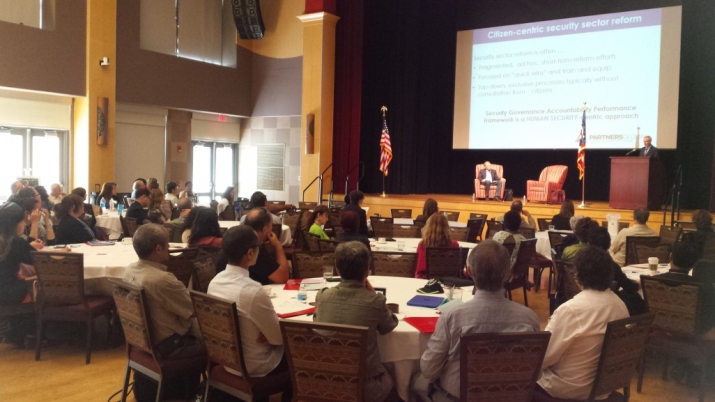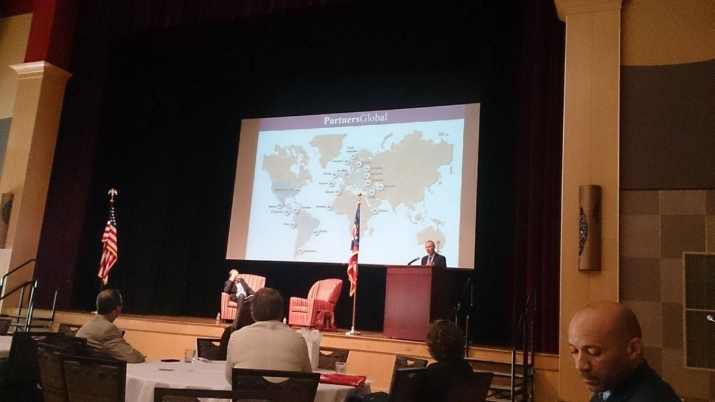FEATURES|THEMES|Social Engagement
Exploring Buddhist Teachings at the 10th International Conference on Conflict Resolution Education
 Day two of the conference. From davidjsmithconsulting.com
Day two of the conference. From davidjsmithconsulting.comFirstly, I would like to thank conference coordinator Jennifer Batton for inviting me to give a presentation at the 10th International Conference on Conflict Resolution Education (CRE), whose theme was “Building Stronger Communities Through Peace, Justice, and Security.” Held from 8–13 June at Ohio State University in the United States, the conference, which featured more than 75 presenters, five keynote speeches, 58 workshops, and 14 pre-conference training sessions, afforded an opportunity to learn about the many issues facing local, national, and international communities, and provided a forum for attendees from more than 10 countries to network and collaborate.
The conference was hosted by the Global Partnership for the Prevention of Armed Conflict, a member-led network of civil society organizations, and Ohio State University’s Mershon Center for International Security Studies, Peace Studies Program, Center for Slavic and Eastern European Studies, John Glenn Center for Public Policy, and Department of Political Science. As a presenter, I found the conference a very enriching experience and an ideal platform from which to explore conflict resolution from a Buddhist perspective in the company of researchers and experts in the field of conflict resolution education. The event also served as a strategic think tank to enable constructive multi-faith dialogue among people actively engaged in peace building around the world.
My presentation was part of a shared panel with C. Paul Anto, a Christian priest who works for the youth peace movement Peace Channel in India, who spoke on indigenous peace building in a multicultural and religious context in areas of northeastern India, such as Nagaland. My own presentation, titled “Can Buddhists Help Restore Harmony in Modern Society?,” concerned the oppression of religious minorities in Bangladesh and Myanmar as well as communal violence in other South and Southeast Asian countries. I proposed resolutions inspired by Buddhist teachings to address religious conflicts at various levels and to promote religious tolerance and harmony.
The first part of my presentation focused on the traditional communal harmony between Buddhists and Muslims in Bangladesh, which was shattered in September 2012 by the circumstances surrounding, and repercussions from, violent incidents in the Ramu administrative region of southeastern Bangladesh. These were triggered by a simple photo tagged on a Buddhist youth’s Facebook page that allegedly insulted Islam, leading to the brutal destruction of Buddhist temples and houses by Muslims in what is considered to be the worst attack on the Buddhist community since Bangladesh’s independence in 1971. The incident affected the balance of peace and security not only in Bangladesh, but also in neighboring Myanmar.
In my presentation, I highlighted two major motives behind violence directed against religious minorities in Bangladesh:
1. Religious. Certain members of Bangladesh’s Muslim majority are seeking to expel non-Muslims from the country. They include Muslim extremists who attack religious minorities to take possession of their land and property, and who wish to see Sharia law applied throughout the country.
2. Political. Certain parties inflict violence against religious minorities for their own benefit. Several political parties believe that the minority communities are a major vote bank for the present ruling party, Awami League, with the result that the opposition parties, which are mostly Islamic ideological parties, instigate looting and brutal attacks to prevent them voting for the ruling government. Religious minorities are frequently attacked after elections as well, whether or not they vote.
My presentation also discussed attacks on Buddhists in Bangladesh that stem from underlying tensions related to the long-term oppression experienced by Rohingya Muslims living in Buddhist-majority Myanmar, as well as attacks directed at minority Muslims in countries such as Sri Lanka and Thailand, where hardline Buddhists have targeted Muslims and Christians.
I then highlighted what Buddhist teachings can tell us about the sources of conflict:
Bad words blaming others, Arrogant words humiliating others.
From these behaviors, Come hatred and resentment.
Hence conflicts arise, Rendering in people malicious thoughts
Dhammapada (T 4:210)
And how the Buddha’s teachings can help to extinguish such violence:
The one who dwells in compassion would not have a conflictual volition;
The one who dwells in loving-kindness would always act most appropriately.
Dhammapada (T 4:210)
 Morning keynote session, day two of the conference. Photo by BD Dipananda
Morning keynote session, day two of the conference. Photo by BD DipanandaI then went on to recommend the following solutions to religious and communal conflict:
1. The integrity of cultural identities and the heritage of oppressed communities need to be recognized and protected, amid efforts to preserve and promote diverse cultural and religious identities.
2. International religious organizations should be invited by a multi-national organization like the United Nations to come together to promote religious harmony.
3. A separate committee should be selected from among the members of the world’s religious organizations to form an independent secular organization for conflict resolution. The members of this neutral body could visit affected areas with a local or national peace-building team to mediate tensions and settle disputes. Such a body could be selected by an international organization that plays an important role in regulating relations between countries, such as the United Nations.
Professor Kathy R. Matsui from Seisen University in Japan, who is actively engaged in peace building, gave a presentation on the role of religion in building peace in northeast Asia. She observed that all religions provide a spiritual and ethical foundation from which to promote peace, and that governments in northeast Asia could find a path to peace through these religious ideals.
It was interesting to see that many conference participants acknowledged the importance of peace building through the adaptation of a coherent policy of spiritual development, in order to build stronger communities. Based on a shared feeling of sympathy and solidarity, a number of peace-loving teachers and students have broadly adopted the principles of the Art of Living Foundation established by the Indian spiritual leader Sri Sri Ravi Shankar. In one workshop, Nian Sanyal, the facilitator of Art of Living in Ohio, explored Ravi Shankar’s key role in conflict resolution via his vision of non-violence shared in public forums and gatherings worldwide. Her presentation emphasized the need to reinforce human values and to recognize our humanity as our primary identity. Her approach was based on a holistic perspective, and comprised physical, emotional, mental, behavioral, and relational aspects considered valuable tools for peace building. She highlighted that sustainable peace can be achieved through the fostering of interfaith harmony and called for multi-cultural education, which are significant aspects of Ravi Shankar’s efforts for peace.
See more
The 10th Intl. Conference on Conflict Resolution Education (CRE) (Alliance for Peacebuliding)
10th International Conference on Conflict Resolution Education Meets at Ohio State (David J. Smith)
Launch of Peace Jobs at Columbus, OH CRE Conference in June (David J. Smith)
Main Conference Workshop Summaries, June 10-11, 2016 (Creducation.org)
Global Partnership for the Prevention of Armed Conflict (Gppac.net)
References
Dhammapada. Quoted in Yeh 2006, 95, 99.
Yeh, Theresa Der-Ian. 2006. “The Way to Peace: A Buddhist Perspective.” International Journal of Peace Studies 11 (1): 91–112. http://www.gmu.edu/programs/icar/ijps/vol11_1/11n1Yeh.pdf.














